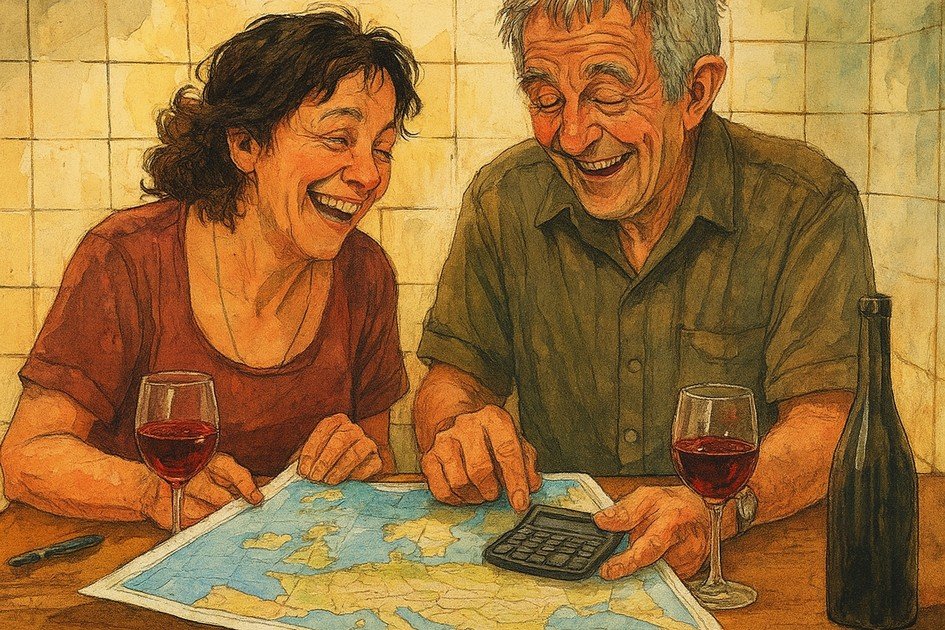Budgeting for a Trip to Europe: 9 Countries That Will Destroy Your Savings (Plus 5 Hidden Gems)
“So is Portugal really that much cheaper than France?” my friend Sarah asked over coffee, her laptop open to a dozen European rental listings. She’d been dreaming of an extended European adventure—maybe three months exploring different countries—but felt overwhelmed trying to figure out where her retirement savings would stretch furthest. Sound familiar? When budgeting for a trip to Europe, planning isn’t just about deciding between Tuscany’s rolling hills and Croatia’s stunning coastline; it’s about understanding how far your travel dollars will actually take you in each destination.
That’s exactly why we’ve created this Europe travel cost calculator and interactive budget chart. Instead of guessing whether Prague is affordable or wondering if a month in Greece fits your budget, you can now compare real costs across dozens of European countries at a glance. This comprehensive guide makes budgeting for a trip to Europe straightforward and stress-free.

Budget Chart: Daily & Monthly Costs by Country
Use this chart to compare the average daily and monthly travel costs in popular European destinations. It’s designed for two mid-range travelers—those who enjoy private accommodation, mix cooking with eating out, and prefer trains or rentals over buses. According to Budget Your Trip’s 2025 travel cost rankings, these figures reflect current market conditions and actual traveler expenses.
| Country | Daily (Per Person) | Monthly (Couple) | Notes |
|---|---|---|---|
| Portugal | €55–€75 | €2,500–€3,000 | Great value; excellent food |
| France | €85–€110 | €3,600–€4,800 | Pricey in cities, rural areas cheaper |
| Spain | €65–€85 | €2,800–€3,500 | Tapas meals save money |
| Italy | €70–€100 | €3,200–€4,500 | North more expensive |
| Germany | €80–€105 | €3,400–€4,700 | Rail network excellent |
| Croatia | €60–€80 | €2,700–€3,200 | Best deals outside summer |
| Albania | €45–€65 | €2,000–€2,600 | One of Europe’s most affordable |
| Greece | €60–€85 | €2,800–€3,400 | Ferry costs add up |
| Netherlands | €95–€120 | €4,000–€5,200 | Budget for bikes and trains |
| Switzerland | €130–€170 | €6,000–€7,200 | Gorgeous, but very costly |
Tip: These are flexible estimates based on 2025 data, regional averages, and seasonal factors. For solo travelers, reduce monthly totals by ~30–35%.
How to Use This Europe Travel Cost Calculator
Below our main comparison chart, you’ll find a personalized trip calculator that takes the guesswork out of budgeting for a trip to Europe. Simply select the countries you’re considering, input how long you’d like to stay in each, and choose your travel style—whether you’re a budget-conscious explorer who’s happy with guesthouses and local markets, or someone who prefers mid-range comfort with occasional splurges.
The calculator instantly shows your projected costs, breaks them down by category, and even offers suggestions for stretching your budget further. When budgeting for a trip to Europe spanning two months, the tool might suggest spending more time in affordable gems like Bulgaria or Albania, then splurging on shorter stays in pricier destinations like Switzerland or Norway.
I’ve found this approach particularly helpful when planning extended trips. Rather than avoiding expensive countries entirely, you can strategically balance your itinerary—perhaps spending three weeks in budget-friendly Prague and Krakow, then treating yourself to one magical week in Amsterdam or Copenhagen. This smart approach to budgeting for a trip to Europe maximizes both value and experience.
Where Does Your Money Actually Go? Understanding European Travel Costs
Let me walk you through what these numbers really mean in practical terms, because “daily budget” can sound pretty abstract until you’re standing in a Venetian café wondering why your cappuccino just cost eight euros.
Accommodation typically represents your largest expense when budgeting for a trip to Europe, but Europe offers incredible variety here. In countries like Romania or Bulgaria, you might find charming guesthouses for €25-35 per night, while similar comfort in Paris or Zurich could easily cost three times that amount. Many experienced travelers I know have discovered the sweet spot of apartment rentals for stays longer than a week—you’ll often pay less per night and gain the freedom to prepare some meals yourself.
Food costs vary dramatically not just between countries, but between dining strategies. In expensive destinations like Norway or Switzerland, grocery shopping becomes your best friend when budgeting for a trip to Europe. I remember chatting with a couple in Bergen who’d budgeted for restaurant meals but quickly pivoted to market shopping and apartment cooking—they still enjoyed the occasional splurge dinner, but their daily food costs dropped from nearly €80 to about €35.
Transportation within countries can surprise you during your Europe budget planning. While Western European rail systems are efficient, they’re not always budget-friendly for extensive travel. The 2025 Global Eurail Pass offers flexible travel starting around €300 for second-class access across multiple countries. Meanwhile, countries like Poland or Hungary offer excellent public transport networks at remarkably reasonable prices. Local transport in major cities ranges from under €2 per day in places like Sofia to €8-12 in expensive capitals.
Activities and sightseeing also follow regional patterns that affect budgeting for a trip to Europe. Many Eastern European cities offer free walking tours, affordable museum entries, and plenty of beautiful architecture you can admire without spending a euro. Western European attractions often cost more, but they frequently offer senior discounts and city museum passes that can provide excellent value for culturally curious travelers.
Europe’s Budget Champions vs. Premium Destinations (2025 Reality Check)
After analyzing costs across the continent, some clear patterns emerge that might surprise you when budgeting for a trip to Europe. The traditional “expensive” versus “cheap” European map has evolved quite a bit, especially since 2022.
The Premium Players haven’t changed much: Switzerland remains stubbornly expensive with costs reaching $2,513 per week, making it crucial to plan carefully when budgeting for a trip to Europe that includes these destinations. Norway and Iceland follow similar patterns, with daily costs often exceeding €100 per person even with careful budgeting. Denmark and the Netherlands follow close behind, though both offer excellent value for what you pay—just expect to pay more for it.
The Sweet Spot Countries offer that perfect balance of affordability and developed infrastructure that mature travelers often appreciate when budgeting for a trip to Europe. Portugal continues to deliver exceptional value, especially outside Lisbon. Greece has become more budget-friendly since its economic challenges, offering incredible food and scenery at very reasonable prices. Slovenia surprises many travelers with its Alpine beauty at Central European prices rather than Swiss ones.
The Hidden Budget Gems represent some of Europe’s best-kept secrets for cost-conscious travelers focused on budgeting for a trip to Europe. Albania offers Mediterranean coastlines at a fraction of Croatian prices. Bulgaria provides ski resorts, Black Sea beaches, and charming mountain towns at prices that seem almost too good to be true. Even Poland, Czech Republic, and Hungary—no longer the bargain destinations they once were—still offer remarkable value compared to their Western neighbors.
What’s particularly interesting is how seasonal timing affects these calculations when budgeting for a trip to Europe. A summer month in Croatia now costs nearly as much as shoulder-season travel in Italy, while visiting popular destinations during off-peak periods can dramatically shift their position on the affordability scale.
Your Personal Budget Travel Map of Europe
Think of our cost calculator as your personal budget travel map—not just showing you where countries are, but revealing the financial landscape you’ll navigate. This becomes particularly valuable when budgeting for a trip to Europe with longer stays or multi-country itineraries.
According to recent European tourism statistics, international arrivals are up 4.9% in early 2025, with travelers increasingly choosing less popular destinations for longer stays. Many travelers successfully structure their European adventures around these cost patterns. They might start in affordable Prague, slowly work their way through reasonably priced Central European capitals, then finish with a splurge week in expensive but unforgettable Amsterdam.
I’ve watched many travelers successfully structure their European adventures around these cost patterns when budgeting for a trip to Europe. They might start in affordable Prague, slowly work their way through reasonably priced Central European capitals, then finish with a splurge week in expensive but unforgettable Amsterdam. Or they’ll anchor a long trip in a budget-friendly base like Portugal or Poland, then take shorter excursions to pricier neighboring countries.
The key insight here is that cost doesn’t always correlate with quality of experience when budgeting for a trip to Europe. Some of my most memorable European moments happened in the most budget-friendly destinations—sharing homemade rakia with a Bulgarian family, discovering an incredible local restaurant in a small Romanian town, watching sunset from a castle in Slovakia that cost less to visit than a single museum in Paris.
This budget map approach helps you see possibilities rather than limitations when budgeting for a trip to Europe. Maybe you can’t afford two months in Switzerland, but you could easily spend two months exploring the Balkans and still have money left for a week in the Swiss Alps.
Frequently Asked Questions About Budgeting for a Trip to Europe
Q: Are these daily costs per person or per couple? A: The chart shows daily costs per person, but we also include monthly estimates for couples since many mature travelers explore Europe together. The couple estimates account for shared accommodation costs, which can significantly reduce per-person expenses when budgeting for a trip to Europe.
Q: How current are these cost estimates? A: We update our database quarterly using current data from booking platforms, local price surveys, and feedback from travelers. The 2025 figures reflect post-pandemic pricing realities, including inflation impacts that have affected different countries differently, ensuring accuracy for budgeting for a trip to Europe.
Q: Can I realistically use this for planning a 3-6 month European trip? A: Absolutely—that’s exactly what many of our users do when budgeting for a trip to Europe. For extended stays, also consider our long-stay visa guides and remember that monthly apartment rentals often offer better value than nightly accommodation rates.
Q: What about seasonal price variations when budgeting for a trip to Europe? A: The calculator includes seasonal filters, but as a rule of thumb, expect summer costs to be 20-40% higher in popular destinations. Current trends show travelers are increasingly choosing shoulder seasons (April-May, September-October) which often provide the best balance of weather and value.
Q: Do you account for senior discounts in your calculations? A: Our base estimates don’t automatically include senior discounts, but many European attractions, transport systems, and accommodations offer excellent deals for travelers over 60. Factor in an additional 10-15% savings in most destinations when budgeting for a trip to Europe.
Your Budget, Your European Adventure
Here’s what I’ve learned from years of helping people with budgeting for a trip to Europe: the “perfect” budget isn’t about finding the absolute cheapest option—it’s about understanding your choices so you can spend your money on what matters most to you. Maybe that’s lingering longer in that perfect Tuscan town, or perhaps it’s splurging on the luxury river cruise you’ve always dreamed about.
Use this Europe travel cost calculator as your starting point, not your final word when budgeting for a trip to Europe. Costs fluctuate, personal priorities vary, and sometimes the most budget-friendly choice isn’t the one that brings you the most joy. What this tool does provide is transparency—you can see exactly what you’re choosing between and make informed decisions about where to save and where to splurge.
Remember too that European travel offers incredible flexibility for adjusting your budget on the go. If you find yourself loving affordable Bulgaria more than expected, you can extend your stay and bank the savings for a future trip. If Prague captures your heart but strains your wallet, you might decide it’s worth every euro and adjust your plans elsewhere.
The goal isn’t to travel Europe on the smallest budget possible—it’s to travel Europe confidently, knowing your money is taking you exactly where you want to go. With the right approach to budgeting for a trip to Europe, proper research using tools like Nomadic Matt’s comprehensive Europe budget guide, and our interactive calculator, you’ll be well-equipped to make informed decisions that maximize both your experience and your budget.
Bookmark this calculator, share it with your travel companions, and remember that the best European adventure is the one that fits both your dreams and your budget. Whether you’re planning a quick two-week jaunt or an extended three-month exploration, mastering the art of budgeting for a trip to Europe ensures every euro spent contributes to memories that will last a lifetime.

Slow Traveler
Thoughtful reflections and sustainable travel tips, hopefully, inspiring readers to pick up their traveling pack and begin their journeys.
No posts
Subscribe to the Newsletter


















